Shade trees also play a vital role in combating climate change

Hoboken’s first parks — Church Square, Columbus, Stevens and Elysian — dating from the late 1880s to 1912, all contain London plane trees. What remarkable foresight the city leaders of that era had, as their investment has lasted for over a century. Potentially, they could last another century as these trees are known to have a life-span of several hundred years. In Hoboken, they have provided a slice of nature for generations of urban dwellers. Today, these trees have grown to an immense stature, some with trunks expanding to three feet in diameter and reaching heights of fifty feet.
The London plane tree is a hybrid between the native American sycamore and the non-native oriental plane tree. Red-brown scales flake to show cream-colored inner bark. It first appeared in London in 1645 and having tolerated the town’s smoke and grime, became London’s most common tree. It also has the ability to withstand drought and other adversities, and thus quickly became popular in parks and streets of other urban areas. The Worcester Tree Initiative said of the London plane tree, “Beyond its reputation as a survivor, this tree is simply worth admiring. The unique bark and interesting branching give it amazing visual appeal—whether summer or winter.”
In the 1990s, Hoboken had the good fortune to hire landscape architect Henry Arnold of Arnold Associates in Princeton, New Jersey to execute the landscape design for Hoboken’s South Waterfront. Mr. Arnold, the author of Trees in Urban Design, understood how trees play an essential role in a city’s character and how they should be viewed as a fundamental part of a city’s infrastructure.
The original plantings at the South Waterfront included a double row of London plane trees in the walkway, a row of Lacebark Elms between the walkway and bike path, and another row of London plane trees between the bike path and the street, totalling some 200 trees all spaced about 20 feet apart. The plantings included an additional 97 London plane trees in a grove at Pier A Park.
Indeed, the character of Hoboken’s South Waterfront linear park is defined by its London plane trees. They connect and unify the public space at the water’s edge along the Hudson River. Their canopy shades the bike path and circumscribes the pedestrian promenade from Newark Street up to Fourth. By their repetition, the trees provide a coherent pattern. The design has garnered numerous awards, including one from the American Society of Landscape Architects and another from the New Jersey Society of Landscape Architects.
Arnold Associates also introduced an innovative planting technique for the South Waterfront. Below the ground at Pier A Park and throughout the promenade, the landscape plan called for an average depth of three feet of air-entrained soil. This light-weight soil mix includes expanded shale which aids drainage and, as the name implies, allows for air to reach the tree roots.
Shade trees are a critical component of a city’s infrastructure. Through photosynthesis, shade trees sequester carbon dioxide and provide oxygen, essential to human life. Large trees also have the capacity to take up significant volumes of water, thus reducing storm-water runoff. They also are able to remove pollutants from the air, including carbon monoxide, nitrogen dioxide, sulfur dioxide and particulate matter, thus improving air quality and creating a healthier environment. Trees contribute significantly to the energy efficiency of buildings.
The landscape architect for Columbus Park, built around 1910, was Charles Nassau Lowrie, who was active in the “City Beautiful” movement and past president and founding member of the American Society of Landscape Architects. The London Plane trees in Columbus Park are a testament to the original design of Lowrie who could envision what they would look like today.
It has been more than twenty years since the park at Hoboken’s South Waterfront was built. Today it serves as a model for how the bleak, nearly treeless stretch to the north, around Castle Point, could be transformed. There is an opportunity to extend the protected bikeway and connect missing portions of the waterfront park as well. The key element, of course, are the trees that provide an aesthetic beauty and unifying theme to the design.
Related Links
With rows of shade trees, a model for trees in urban design
Landscape design for Columbus Park still shines 108 years later
Urban shade trees are the key to building sustainable, healthy cities
The morning after Superstorm Sandy: Hoboken’s waterfront parks
Public parks provide essential benefits
Col. Stevens vision for Hoboken still valid 200 years later
Editorial: A Once-in-a-century Opportunity
Plan for the Hoboken Waterfont
Roots over the river

